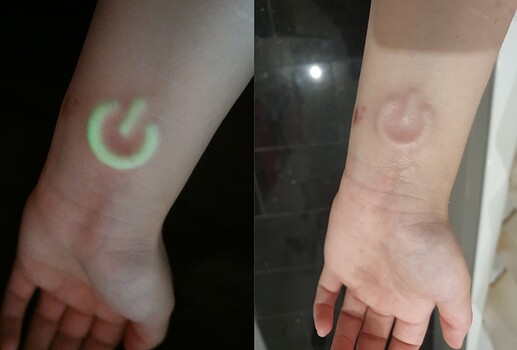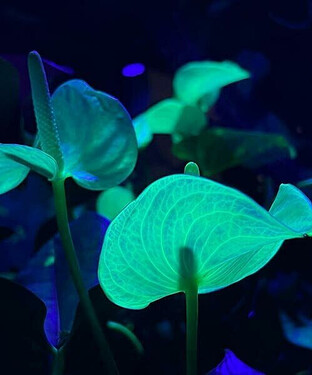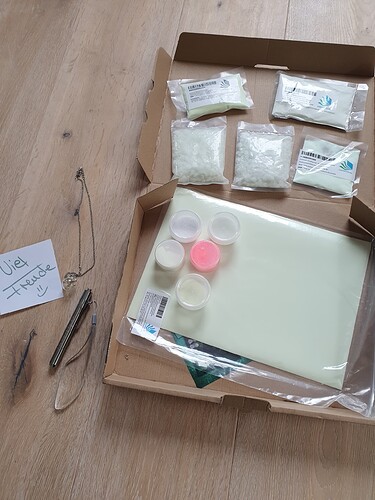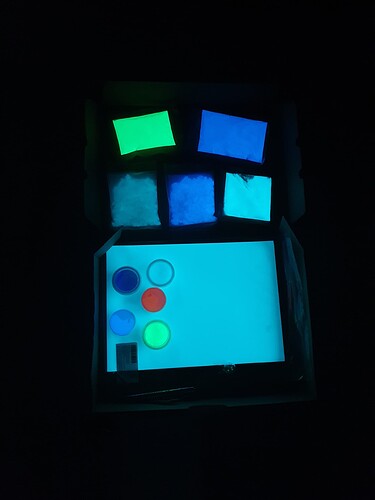I’d like to see the tech get to the point where we could have subdermals that worked without the need for external power. Imagine being able to mix to ink and blinkies… that, would be sick!!
Problem is, at least where I live, UV-light has gotten so rare in clubs… some 15, 20 years ago, it was used almost everywhere, but nowadays it’s almost extinct. So you might end up with a tattoo that’s invisible in normal light as well as in clubs ![]()
For a glow in the dark effect, those actually exist. Not for LED and the like, but nightglow is definitely possible.
Oh, and the company selling the glow powder answered back - they said that a) it’s possible to mix the pigments with some carrier and use them for bodypainting, b) if irritations occur, it’s most likely due to the carrier and not because of the pigments (hints at pigments being quite “harmless”, I guess!) and that c) they can’t provide some sort of “certificate of harmlessness” because it’s a substance that should not end inside of the body.
For me, it sounds like the pigments are quite safe but they can’t “officially” say so, because they didn’t pass any official tests for that. ![]()
This is what i was thinking. Might be because largely left my clubbing days begind me… but i dont see myself hanging out under UV lights that much and yeah… clubs are all lasers and such now… (nobody needs to be looking at white flecks on everyones shirts ![]()
![]()
![]() )
)
Like glow in the dark ink? I might need to look into that… ive stuck with all black and gray work…but some of my stuff with a bit of “pop” added would be insane.
Nah, that’s something I’m currently doing some research on, but it’s still very experimental. But you said something about glowing subdermals, and I actually have one of those (second one is soon to come ![]() )
)
Available as this power button and small stars. It’s basically a classic silicone subdermal that glows in the dark ![]()
Ohhhhhhh linky ![]()
Dunno where you’re at, but that’s the official US page of Steve Haworth, who makes those implants:
I think you’re Europe-based, though - so best bet is to find a skilled artist for the install and tell them to order that for you ![]()
edit: oh, my traditional disclaimer - if you need an artist and you’re willing to travel to Germany, I can recommend my artist obviously ![]()
Just gathering some opinions here - so, my fellow glowy-(and wannabe-glowy)people, what do y’all think of that?
Specifically the pigments, of course. They are strontium-aluminate-based, I read somewhere on the page that they’re covered with silicone (-> waterproof), pigment size is about 65-85 µm, and the company claims they’re so safe they could be used for children’s toys. And as far as I know, that’s quite a statement in the EU - I think several official tattoo inks wouldn’t pass that.
They have a safety data sheet for the pigments, I think it’s only available in German, and it basically says you should not inhale it (because it’s fine enough to end up in your lungs), rub it into your eyes or something like that. Acute toxicity is not really a thing, the LD50 for rats is >2000 mg / kg.
To be honest, I never analyzed a safety data sheet before, and I can see that several things were simply not tested at all (because those pigments are not used as food or tattoo inks, but just for decoration), but all in all, it looks okay-ish.
Any thoughts on that? Anything I’m totally not seeing or something like that?
Still pondering on using that stuff…
I have my pigments from there.
I chose them because they are based in the eu and they provide some data sheets for their pigments.
My tattoos still glow as bright as a few week ago.
Auf dich ist Verlass ![]()
Thanks, this sounds good - maybe I’ll try it out after I got my glowy star (and it’s healed^^) ![]()
Sounds good to me. I’m pretty sure with my dating history, I have had worse stuff in me ![]()
Of course we’re not plants (not that I know) but I wonder if something of the same idea would work for meatbags (I doubt it).
I basicly just put the cleaned and sterile powder into the wound and let the powder soak up the blood. After letting the scab form for a bit i covered it with a patch so it doesn’t infect and that was it. At some point the scab falls off with the leftover pigment. I didn’t do any special aftercare. The blood clotts pretty quickly after soaking into the powder
Okay, this sounds simple enough ![]()
How happy are you with the results? I saw some ink rubbings, and they were relatively discreet, colour-wise… so is there any glow left by now?
Oh, and I got the pigments I ordered - so far, they glow a lot!
The classic green one is by far the brightest, and the blue-green might be suitable for tattooing as well. The blue one might work, or maybe not, and the violet one will definitely not glow from beneath the skin. The red one might work, maybe, but it is red in daylight as well - so I guess I won’t use it.
Still thinking about how to desinfect the powder… thought about a pressure cooker? Maybe oven? I’m totally clueless about this, but I’m gonna do some research ![]()
Improvised autoclave?
Hot air sterilization is also common but it requires a higher temperature and takes more time.
Can the powder take the heat without breaking down?
Yes, kinda… problem is, I don’t own a pressure cooker, and those things are too expensive if you don’t really need them.
I did some research - I’ve got glasses here that can take up to 180°C (356°F), and according to the manufacturer, the pigments can take 1000°C (1832°F) ![]()
So I guess they should be safe if I put them into the oven at 150°C - 160°C for half an hour or so… and pretty much everything (viruses, bacteria, fungal spores) gets destroyed a little above 120°C, that’s why boiling water isn’t enough and you need the additional pressure of the autoclave. Prions need 200°C dry heat, but I naively hope that there are no prions in my pigments… ![]()
My current plan is to put the pigments into the little glasses, run them through the oven, seal them and done.
As a carrier fluid, I am leaning towards glycerine, mostly because it is thicker than water, so the pigments should mix better and not sink down as fast. I’ve got a new, sealed package - I know it’s most likely not sterile, but I think it’s as clean as it can get, so I hope that’s enough.
IIRC, hot air sterilization was supposed to take two hours at 160C. Probably to make sure that everything reaches a temperature above 120C.
Also, pressure cookers aren’t great at evacuating the air like an actual autoclave. Adding a tube to the lid shouldn’t be too hard but then you’re left with an Improvised autoclave that might be dangerous for cooking.
So it’s probably best to stick with the oven. But I recommend verifying the temperature with an accurate thermometer. I guess that the type that uses a thermocouple is probably the most recommended for things like this.
I was under the impression you had many a body mod installer friend,
Can you not just ask them to autoclave some stuff for you?
I feel like that’s the equivalent of asking to use a copy machine… maybe they charge you a few bucks… but it’s not really any effort
True - I mixed things up… So yeah, I guess I’ll go with 160°C, should be no problem for neither the glasses nor the pigments ![]()
And considering the pressure cooker - I’m actually slightly afraid of those things, especially if I would buy a “cheap” one. It’s still high temperature and pressure, that’s not something I like to play with ![]()
Yeeees… well. Arnulf in Cologne might actually do it for me, but he wasn’t too fond of my idea of getting glowing selfmade ink underneath my skin. Plus, I totally forgot to ask that last time I was there, and I don’t know when I’ll get there again - might very well take some months or so, dunno.
My local piercer is a very nice guy, but he is usually very… “law-abiding” and correct. I doubt he’d let me use his autoclave, and definitely not if I tell him what I need the pigments for. DIY-stuff is not really something those guys like ![]()
To be honest, I generally agree with them - I would totally prefer some officially made tattoo ink, and some officially trained pro to tattoo me. But both of that seems to be impossible right now, so… me and a friend of mine are gonna tattoo me with totally selfmade ink containing pigments that are not inteded to be used for that. Sounds fun. ![]()
Oh, so this may be of interest or constructive info
I’ve been tinkering to sort of help @mrln to get his glow powder into their chips
I don’t think I mentioned that his to them yet come to think of it
I’ve got some experience with liquid resins and adhesives and dispenser equipment / methods etc
When I was experimenting with the glow powder I got my hands on, which seems to be of standard particle size for the stuff
This stuff doesn’t blend or mix well
It’s heavy enough it is highly motivated to settle out, even in some resins I was trying
You might need to look into (if it’s chemically even possible) grinding it as fine as you can
Pestle and mortar? Idk I’ve got no experience with that…. But pulverizing it as fine as possible might be worth looking into
Assuming the europium doping of whatever that part is the equation allows for it
Yep, that’s something they say on the manufacturer’s site as well… it will definitely sink down fast in water and other thin liquids, and it will settle out in glycerin as well (though hopefully not as fast).
Problem - at least for my use case ![]() - is, if the particles are too small, they won’t work for tattooing. The particles have to be big enough to be “hold” by the skin, otherwise they will just be transported away by the lymph. That’s actually what happens when you get some tattoo removal - the laser breaks the pigments down to a smaller size, so they can be removed by your own body’s transport system.
- is, if the particles are too small, they won’t work for tattooing. The particles have to be big enough to be “hold” by the skin, otherwise they will just be transported away by the lymph. That’s actually what happens when you get some tattoo removal - the laser breaks the pigments down to a smaller size, so they can be removed by your own body’s transport system.
While the pigments I bought now are definitely bigger than those in many tattoo inks (though it’s not really easy to find that out, because information about tattoo inks is rarer than I thought… http://whatsinmyink.com/ is quite interesting, and I’m definitely less hesitant to make my own ink now ![]() ), grinding them will definitely have an impact on the coating they have… and from what I know, the coating leads to a good / better resistance against humidity. Strontium aluminate based pigments can lose luminosity when exposed to water, so that might be a risk.
), grinding them will definitely have an impact on the coating they have… and from what I know, the coating leads to a good / better resistance against humidity. Strontium aluminate based pigments can lose luminosity when exposed to water, so that might be a risk.
So my plan for now is to (more or less) “sterilize” the pigments, mix them with glycerine in a pretty high ratio (thinking about 1:1 or 1:2), and just keep stirring it while poking myself. Every part of that is definitely not optimal, but it should work and it’s not totally reckless. Gonna try some small spot first, let it heal up and see a) how my body reacts to it and b) how much / long it glows. If the green one is very visible, I might try out the other colours as well ![]()




